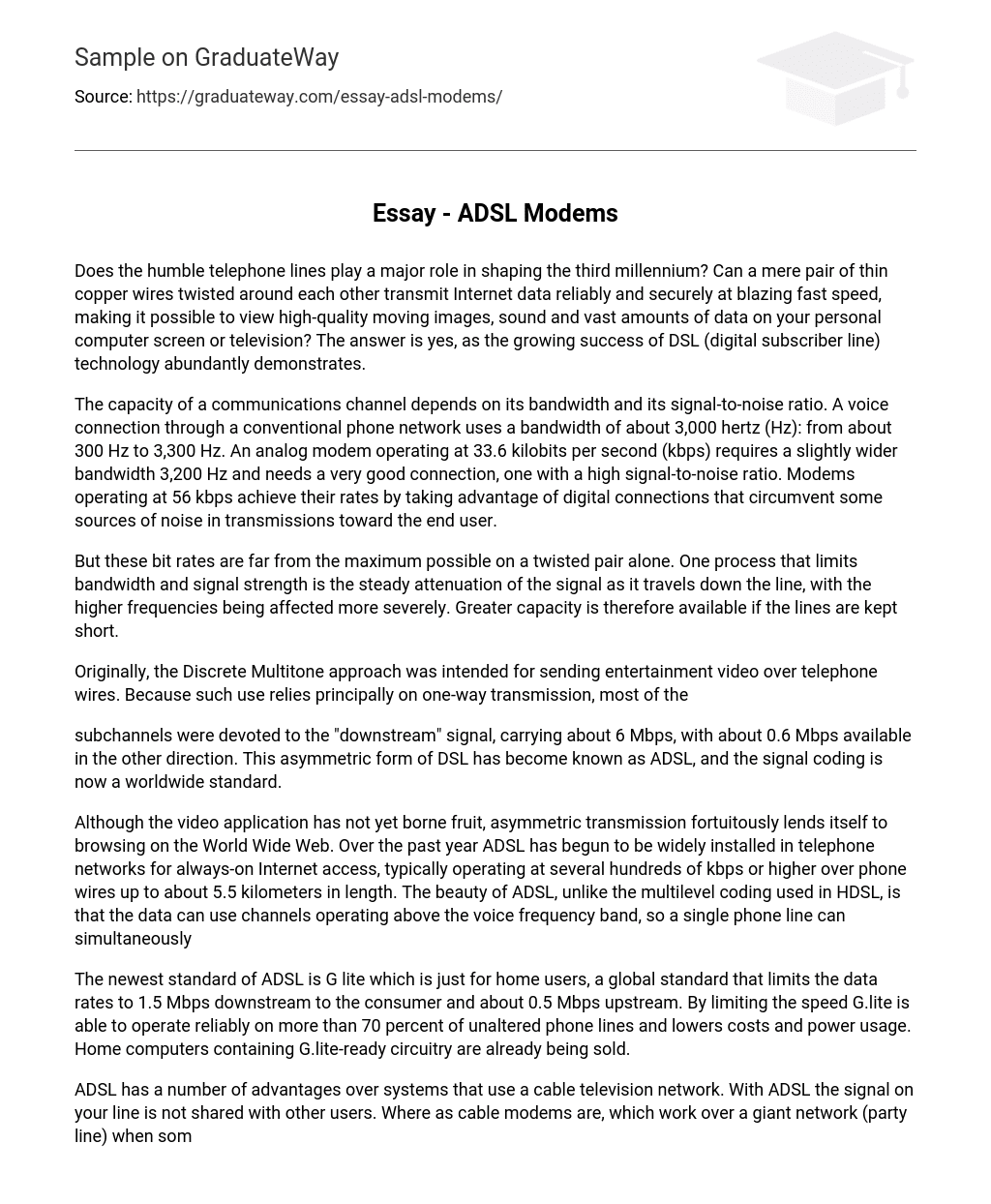Can telephone lines have a significant impact on the future? Can twisted copper wires transmit Internet data securely, reliably, and at high speed to enable viewing of high-quality moving images, sound, and large amounts of data on personal computers or televisions? The answer is yes, as proven by the increasing success of DSL (digital subscriber line) technology.
The capacity of a communications channel is determined by its bandwidth and signal-to-noise ratio. In a traditional phone network, a voice connection uses a bandwidth of around 3,000 Hz (ranging from 300 Hz to 3,300 Hz). An analog modem with a speed of 33.6 kbps requires slightly wider bandwidth of 3,200 Hz and depends on a high signal-to-noise ratio. However, modems operating at 56 kbps can achieve higher rates by utilizing digital connections that eliminate particular sources of noise during transmission to the end user.
However, the current bit rates on a twisted pair are not at their maximum potential. The signal’s bandwidth and strength are limited by the steady attenuation as it travels along the line, with higher frequencies experiencing greater impact. To achieve greater capacity, it is necessary to keep the lines short.
The original purpose of the Discrete Multitone approach was to transmit entertainment video over telephone wires. This is primarily for one-way transmission, so it relies heavily on that aspect.
The subchannels were assigned for transmitting the “downstream” signal, with a capacity of approximately 6 Mbps. Conversely, only about 0.6 Mbps were allocated for data transmission in the opposite direction. This form of DSL is known as ADSL and is recognized worldwide for its asymmetrical nature. The signal coding has been standardized globally.
Although video application has not yet yielded results, browsing on the World Wide Web is conveniently facilitated by asymmetric transmission. ADSL has been increasingly implemented in telephone networks for constant Internet access, typically achieving speeds of several hundred kbps or higher over phone wires of up to approximately 5.5 kilometers in length. Unlike the multilevel coding employed in HDSL, ADSL enables data utilization on channels operating beyond the voice frequency range, allowing for simultaneous use of a single phone line.
The latest ADSL standard for home users is G.lite. It is a global standard that restricts data rates to 1.5 Mbps downstream and approximately 0.5 Mbps upstream. By limiting the speed, G.lite ensures reliable operation on over 70% of unmodified phone lines while reducing costs and power consumption. Home computers with G.lite-compatible circuitry are already available for purchase.
ADSL offers several benefits compared to cable television network systems. Unlike cable modems, ADSL ensures that the signal on your line is not shared with other users. Cable modems function over a large network, similar to a party line, where other users could potentially access your data signal while someone else is receiving data. In contrast, telephone wires provide physical security for your data transmission.
The backbone networks for ADSL transport combined signals for several hundred consumers at speeds of 155 Mbps and higher. In comparison, a television channel has a maximum throughput of approximately 24 Mbps.
Under heavy use by hundreds of cable modems, the effectiveness of ADSL is greatly limited. Furthermore, the ADSL traffic benefits from a statistical economy of scale, as demonstrated by 1,550 people sharing it.
When multiple users are sharing a backbone, it is more effective to have a speed of 155 Mbps instead of 240 Mbps. However, this is only true if the shared speed is capped at 24 Mbps.
Despite cable networks having a 90 percent reach in U.S. households, they are not accessible to numerous businesses. In comparison, telephone networks have extensive availability and play a vital role in facilitating efficient usage.
Upgrading the cable network with fiber optics and two-way transmission equipment requires a significant investment of billions of dollars from cable operators, while ADSL also utilizes two-way transmission equipment.
These telephones are the same as the ones utilized by Alexander Graham Bell in the 19th century.





